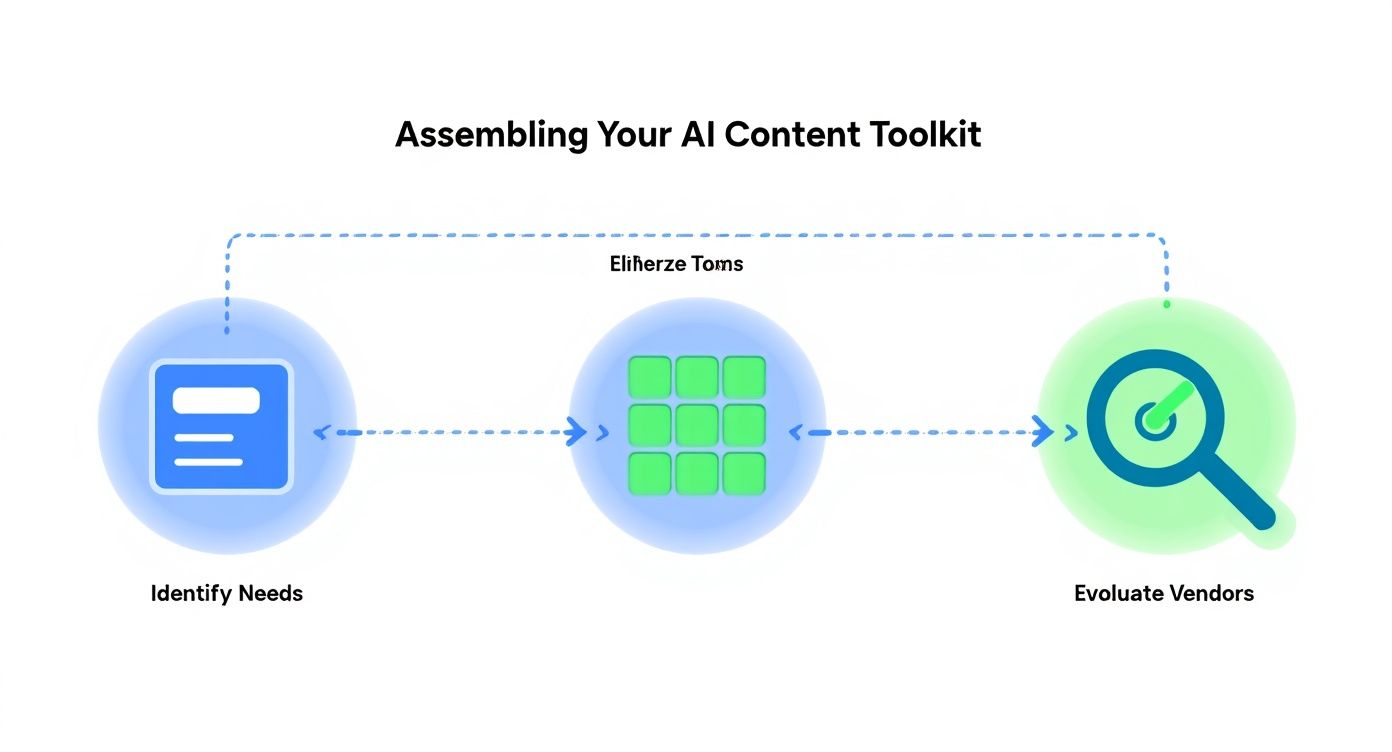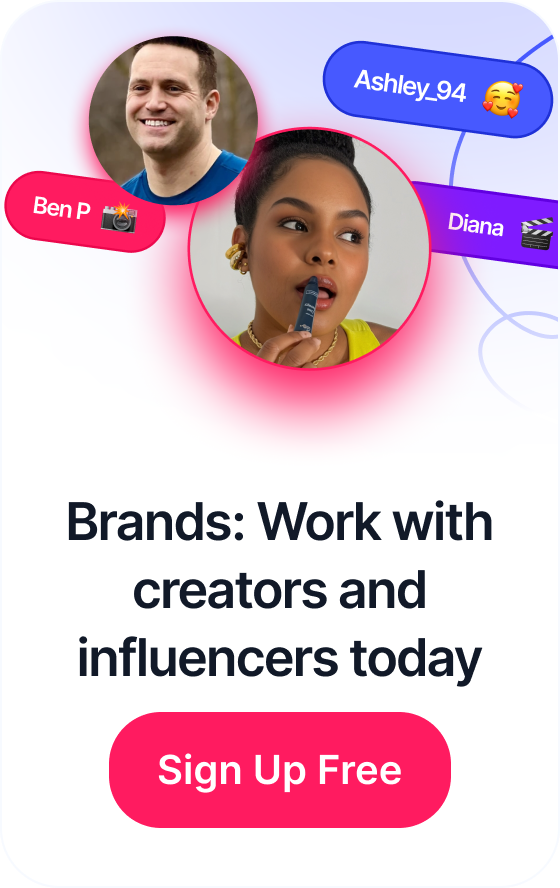 7 Key Benefits of Influencer Marketing for Brands in 2025
7 Key Benefits of Influencer Marketing for Brands in 2025
Using AI for content creation isn't some far-off idea anymore; it's a real-world strategy that smart marketing teams are using to get more done, faster. Think of it as an assistant that helps with the grind—brainstorming, outlining, drafting, and optimizing—so you can focus on big-picture strategy and genuine creativity.
Table of Contents
How AI Is Reshaping Content Marketing

The whole conversation around AI in marketing has completely changed. What used to be a debate about "if" is now a scramble to figure out "how." The sharpest teams aren't using AI to replace their talented writers and strategists; they're using it to supercharge them. This playbook is designed to help you make that happen without the headaches.
Instead of burning hours staring at a blank page, marketers can now fire up an AI tool and get dozens of solid ideas in minutes. This is a game-changer. It frees up your team's most valuable resource—their creative energy—for work that actually moves the needle, like refining your brand's voice, talking to customers, or dreaming up a campaign angle no one else has thought of.
Your workflow transforms from a slow, manual process into a dynamic partnership between human expertise and machine efficiency.
The Real-World Advantages
The benefits here aren't just theoretical. Teams that are already integrating AI are seeing tangible, measurable wins.
- Faster Production: AI collapses the time it takes to get from a concept to a published article or post. This means you can hit aggressive content calendars and jump on market trends before they're old news.
- Smarter Personalization: By crunching massive amounts of data, AI helps you tailor your messaging to specific audience segments. Your content suddenly becomes more relevant, more engaging, and feels like it was written just for them.
- More Strategic Focus: Let the machines handle the repetitive stuff. Automating tasks like drafting social media updates or writing meta descriptions frees your team to focus on high-level strategy, deep analysis, and killer creative storytelling.
The numbers back this up. The percentage of content marketers who plan to use AI is expected to hit 90% by 2025—a massive leap from 64.7% in 2023. And what are they using it for? Mostly for outlining content (71.7%) and brainstorming (68%), proving its value as a powerful creative partner.
We've put together a simple table to show how AI slots into the different stages of your content workflow.
AI's Role in the Content Creation Lifecycle
This table breaks down how AI tools can be applied at each step of the content creation process, from initial idea to final analysis.
| Content Stage | Common AI Application | Primary Benefit |
|---|---|---|
| Ideation & Research | Topic generation, keyword research, trend analysis | Uncovering new content angles and data-backed ideas quickly |
| Outlining & Structuring | Creating logical content flows and detailed outlines | Building a solid foundation for a comprehensive piece in minutes |
| Drafting & Writing | Generating first drafts, writing social copy, creating summaries | Overcoming writer's block and accelerating initial content production |
| Editing & Optimization | Grammar/style checks, SEO suggestions, headline variations | Refining content for clarity, engagement, and search visibility |
| Distribution & Promotion | Writing email subject lines, social media posts, ad copy | Crafting compelling promotional assets tailored to each channel |
| Analysis & Measurement | Content performance analysis, sentiment analysis | Gaining deeper insights into what resonates with your audience |
As you can see, AI isn't just a single tool for one job; it's a versatile assistant that can provide value across the entire lifecycle.
AI isn't about erasing the human element; it's about refining it. The real goal is to automate the tedious parts so your team can pour their brainpower into what truly matters: creativity, critical thinking, and building a real connection with your audience.
This new reality also brings up interesting questions about different kinds of content, like the stuff generated by AI versus authentic user-generated content (UGC). Getting a handle on the differences and synergies between UGC vs. AIGC is key to building a modern strategy that balances human authenticity with machine-powered efficiency. And that's exactly what this guide will help you do.
Building Your AI Content Strategy Framework
Jumping into AI without a plan is like sailing without a map—you'll definitely move, but probably not toward your destination. Just firing up AI tools to pump out content isn't a strategy; it's a tactic. A real strategy starts with clear goals and a solid framework that guides every single decision you make.
Without that structure, you risk flooding your channels with a huge volume of generic, off-brand content that just doesn't connect with your audience. Remember, the goal isn't just to produce more, but to produce better and way more efficiently.
Defining Your AI Content Goals
Before you write a single prompt, you have to ask yourself: what do we actually want AI to do for us? Vague goals like "create more content" aren't going to cut it. You've got to get specific.
Are you trying to dramatically speed up blog production? Maybe you want to deepen your SEO keyword coverage across a dozen new topic clusters. Or perhaps the goal is to personalize email campaigns at a scale you could never manage manually.
Your goals will dictate exactly how you use AI.
- Accelerating Production: If your main goal is raw speed, you'll likely use AI to generate first drafts of blog posts or product descriptions. Your team’s role then shifts to editing and refining that initial output.
- Deepening SEO Coverage: For SEO, AI is a powerhouse research assistant. It can identify topic clusters and long-tail keywords your team might have overlooked. From there, it can help outline comprehensive articles to cover those topics.
- Scaling Personalization: If personalization is the name of the game, AI can create dozens of variations of ad copy or email subject lines, all tailored to different customer segments.
Building out a strong framework from the start is non-negotiable. Getting a handle on a modern AI SEO strategy is a great place to start, as it ensures your efficiency gains also lead to better search performance.
Human-First vs. AI-Assisted Content
A classic mistake is trying to shoehorn AI into every single part of your workflow. The best, most successful strategies I've seen all recognize that some content absolutely demands a human-first approach. Other types, however, are perfect for AI assistance. Nailing this distinction is critical for maintaining quality and brand authenticity.
Create a clear content hierarchy to guide your team. This simple exercise prevents you from accidentally automating the very content that builds the most trust and connection with your audience.
| Content Type | Recommended Approach | Rationale |
|---|---|---|
| Thought Leadership & Opinion | Human-First | These pieces are built on unique experiences, sharp perspectives, and credibility—things AI simply can't fake. |
| In-Depth Case Studies | Human-First | The nuance, storytelling, and customer insights in a great case study require a deep human understanding. |
| First Drafts & Outlines | AI-Assisted | AI is fantastic at structuring ideas and destroying the "blank page" problem, saving your team hours of initial work. |
| Social Media Updates & Captions | AI-Assisted | For high-volume, short-form content, AI can generate creative variations in seconds, making A/B testing a breeze. |
| Product Descriptions | AI-Assisted | AI can generate consistent, feature-focused descriptions at scale. Your team can then come in and polish them to perfection. |
| Internal Communications | AI-Assisted | Need to summarize meeting notes or draft an internal announcement? AI can handle that, boosting internal efficiency. |
By categorizing your content needs like this, you empower your team to use AI where it adds the most value, all without sacrificing the quality of your most important brand assets.
Your AI strategy should never be about replacing your team's creativity. It's about building a system that handles the repetitive, grunt work, freeing up your experts to focus on the high-impact, strategic work that only they can do.
Creating a Brand Bible for Your AI
One of the biggest headaches with using AI for content is keeping a consistent brand voice. Left to its own devices, any AI will churn out generic, robotic copy that feels completely disconnected from your brand. The solution? You have to train it.
Think of your AI as a new junior writer who needs crystal-clear guidance. A "brand bible" is a dedicated document you feed into the AI to teach it exactly how to write for you. This is a foundational piece of any scalable AI workflow.
Here’s what your AI brand bible should include:
Core Messaging: Clearly spell out your company's mission, value proposition, and key talking points. What are the absolute most important messages you want to hammer home in every piece of content?
Audience Personas: Get detailed here. Describe your target audience, including their biggest pain points, their goals, and the kind of language they actually use. This context helps the AI write for a real person, not a faceless void.
Tone of Voice Examples: This is huge. Provide several "before and after" examples. Show the AI a generic sentence, then rewrite it in your distinct brand voice, explaining the specific changes you made and why.
Word & Phrase Library: Create two lists: words to use and words to avoid. For example, a fun, energetic brand might include words like "awesome" and "kickstart," while banning corporate jargon like "synergy" and "leverage."
This brand bible becomes a core asset in your prompting strategy. Instead of explaining your brand voice in every single prompt, you can simply instruct the AI to adhere to the guidelines in the attached document. This ensures consistency and saves a ton of time on every project.
Crafting Prompts That Deliver Quality Content

We've all seen it. The generic, bland, soulless content that screams "I was written by a robot." The difference between that and a sharp, near-publishable draft almost always comes down to a single thing: the quality of your prompt.
Asking an AI to "write a blog post about email marketing" is a recipe for a forgettable article. You’ll get a C+ effort that reads like a thousand other posts already out there. If you want to get real value out of these tools, mastering prompt engineering is non-negotiable.
Think of it like briefing a new junior writer. A vague request gets you a vague result. But a detailed brief packed with context, clear goals, and guardrails? That’s how you get what you actually need. A powerful prompt isn't just a question; it's a structured command that leaves nothing to chance.
The Anatomy of a Powerful Prompt
To get beyond basic requests, your prompts need to be layered with specific instructions. Each piece you add acts as a guardrail, steering the AI toward content that’s on-brand, relevant, and genuinely useful.
Here’s what I’ve found works best:
- Assign a Persona: Tell the AI who to be. Giving it a role grounds the response in a specific voice and knowledge base. Instead of a generic writer, try: "Act as a seasoned cybersecurity analyst with 15 years of experience in enterprise security."
- Provide Critical Context: This is the why. Who are you trying to reach? (e.g., "small business owners new to digital marketing"). What's the goal of this piece? (e.g., "to drive sign-ups for our upcoming webinar").
- Define the Format: Get explicit about the structure. Don’t just ask for an article. Specify something like, "A 1,200-word guide with an introduction, three main sections with H3 subheadings, and a concluding FAQ section."
- Specify Constraints and Rules: This is where you dial in the details. Define the tone ("conversational and encouraging"), list SEO keywords to include ("AI content workflow," "prompt engineering tips"), and call out what to avoid ("do not use corporate jargon or buzzwords").
When you weave these elements together, you're not just asking a question. You're building a comprehensive brief that turns a simple text generator into a strategic partner.
Before and After Prompt Examples
Let's make this real. Imagine you need an outline for a blog post about user-generated content (UGC).
Weak Prompt (The "Before"):"Give me an outline for a blog post about UGC."
This is what I call a "lazy prompt." You'll get back a generic, predictable structure that hits on the most obvious points like "builds trust" and "is authentic," but offers zero depth or a unique angle. It's basically useless.
Strong Prompt (The "After"):"Act as a senior content strategist for a DTC e-commerce brand targeting Gen Z shoppers. Create a detailed outline for a 1500-word blog post titled 'Beyond the Hype: How UGC Drives Real Sales for Modern Brands.' The goal is to convince brand managers to invest in a UGC platform. The tone should be authoritative yet approachable. Include sections on building social proof, increasing conversion rates with authentic visuals, and a case study example. Ensure the outline includes specific data points and H3 subheadings for each section."
See the difference? The second prompt gives the AI a persona, a target audience, a clear goal, a specific tone, and structural rules. The result is a strategic, targeted outline that a writer can actually run with.
Advanced Prompting Techniques for Better Logic
Once you have the basics down, you can start using more advanced techniques to coax even better, more logical outputs from the AI.
Chain-of-Thought (CoT) Prompting
This is a game-changer. You essentially ask the AI to "think out loud" by breaking a complex request into a sequence of smaller, logical steps. Instead of just asking for the final answer, you guide its reasoning process.
For example, when creating a content strategy, you could add: "First, analyze the provided audience persona. Second, identify their top three pain points. Third, brainstorm five content topics that directly address these pain points. Finally, present these topics in a markdown table." This step-by-step guidance leads to a far more coherent and well-reasoned output.
Few-Shot Prompting
This technique is all about showing, not just telling. You give the AI a few examples of exactly what you want before asking it to generate something new.
By providing a few high-quality examples of the output you expect, you train the AI in real-time on your specific style and format requirements. This is one of the fastest ways to improve content consistency.
Let's say you need social media captions that match your brand voice. Your prompt could look like this:
"Here are three examples of our brand's Instagram captions:1. [Your Example 1]2. [Your Example 2]3. [Your Example 3]
Now, write three new captions for our upcoming product launch, following the same witty and energetic tone."
This is incredibly effective for maintaining a consistent voice across dozens of AI-generated assets. You stop getting generic mush and start getting drafts that actually sound like you.
Assembling Your AI Content Creation Toolkit
Once your strategy is locked in, it’s time to talk tools. The market is flooded with AI options, and it’s easy to get overwhelmed. But the goal isn’t to find one perfect, all-in-one piece of software. It’s about building a smart, complementary stack that actually fits your workflow.
The growth in this space is staggering. We're talking about a market projected to blow past $66.62 billion by the end of 2025 and potentially hit $1.3 trillion by 2032. With tools like ChatGPT already capturing a massive 62.5% share of the consumer market, it's clear there's an ocean of options out there. This isn’t a decision to rush; a deliberate choice now will pay dividends later.
Categorizing Your AI Tool Needs
Before you even start looking at specific vendors, you need to figure out what you actually need. A good way to approach this is to break down your needs by function. Most AI content tools fall into a few main buckets.
- Text Generators: These are your content workhorses. They're fantastic for churning out first drafts, brainstorming outlines, scripting social posts, and writing ad copy. Think of them as your go-to writing assistants.
- Image and Video Creators: From custom blog banners to quick-turnaround social videos, these tools bring your ideas to life visually. For any brand producing a high volume of visual content, these are non-negotiable.
- Research and SEO Assistants: These platforms are built to crunch search engine data. They’re indispensable for keyword research, spotting content gaps, analyzing what competitors are doing, and optimizing your content so it actually gets seen.
- Editing and Quality Control Tools: This is your final polish crew. AI-powered grammar checkers, plagiarism detectors, and style editors help you clean up drafts and make sure everything is on-brand and error-free.
Mapping your workflow against these categories will take you from a vague "we need an AI tool" to a much more actionable "we need a text generator for blog drafts and an SEO assistant for keyword research."
How to Evaluate AI Content Vendors
With your categories defined, you can start vetting potential software. Don't just Google the most popular names and call it a day. You need a structured process to find the tool that fits your team like a glove.
Reading through guides like the Top AI Tools for Content Marketing is a great place to start your shortlist. From there, run your top contenders through a consistent checklist.
Your evaluation checklist should cover:
- Integration Capabilities: Does it play nice with your existing tech stack? A tool that seamlessly connects to your CMS, project management platform, or social scheduler is going to prevent a lot of headaches.
- Team Collaboration Features: If more than one person will be using it, you need features like shared workspaces, user roles, and commenting. These are crucial for keeping everyone on the same page.
- Data Security and Privacy: This is a big one. How does the vendor handle your data? Make sure they have crystal-clear policies on data ownership and security, especially if you're working with sensitive company information.
- Customization and Training: Can you teach the AI your brand’s unique voice and style? The best tools let you create a "brand bible" or upload style guides, which is a game-changer for maintaining consistency.
- Ease of Use and Learning Curve: How intuitive is the interface? A tool can have all the bells and whistles in the world, but it's worthless if your team finds it too confusing to use every day.
The best AI tool isn’t the one with the most features. It's the one that solves your biggest content bottleneck with the least amount of friction.
Comparing Tools for Your Workflow
To put this all into perspective, let's think about how different tools serve different needs. For a small B2C brand, a tool that excels at generating punchy social media copy might be the top priority. For a large B2B enterprise, a platform with robust SEO analysis and long-form content generation is probably more important.
Here's a simple framework to help you compare your options.
AI Content Tool Comparison Framework
This table provides a high-level look at different categories of AI tools, helping you pinpoint what to look for based on your team's specific content goals.
| Tool Category | Primary Use Case | Key Evaluation Criteria | Example Tools |
|---|---|---|---|
| Text Generation | Drafting blog posts and social media copy | Brand voice customization, collaboration features | Jasper, Copy.ai |
| Image Creation | Creating custom blog headers and ad visuals | Style consistency, image rights and ownership | Midjourney, DALL-E 3 |
| SEO Assistance | Keyword research and on-page optimization | Quality of data, integration with writers | SurferSEO, MarketMuse |
By thinking through your needs first, creating a solid evaluation checklist, and comparing vendors against your actual workflow, you can build an AI toolkit that truly works for you. This deliberate approach ensures your investment is a smart one—perfectly aligned with your budget, team, and content strategy.
Putting a Human in the Loop Is Non-Negotiable
Let's get one thing straight: AI is a massive accelerator for content creation, but it is absolutely not an autopilot. The single biggest mistake I see brands make is treating AI-generated text as a finished product. That's a fast track to producing generic, often inaccurate content that will kill brand trust and completely fail to connect with your audience.
The only smart way forward is to build a human-in-the-loop (HITL) workflow. This means every single piece of AI-generated content is treated as a first draft—a starting point that needs human expertise, creativity, and critical oversight before it ever goes public. Think of it as your quality control safety net.
Your team’s role has to shift. They're no longer just pure creators; they are now expert curators and editors. They become the essential final filter, responsible for injecting AI drafts with the nuance, personal stories, and unique perspectives that only a human can bring to the table. Skip this step, and you're just adding to the noise online.
The Essential Quality Control Checklist
A structured review process is what ensures nothing slips through the cracks. It’s how you turn a raw AI draft into a polished, credible, and on-brand asset. Your team’s checklist should be a mandatory gate for every piece of content.
This is all part of a larger process that starts with identifying your needs and evaluating vendors to build a solid toolkit.

This workflow visualizes those foundational steps, and your quality control process needs to be just as methodical. Here's what your team must verify:
Factual Accuracy: AI models are notorious for "hallucinating," which is a polite way of saying they make things up. Every single statistic, claim, and data point has to be rigorously double-checked against reliable sources. There are no shortcuts here; one wrong fact can demolish your credibility.
Brand Voice and Tone: Does this actually sound like you? This part of the review involves rewriting awkward sentences, swapping out generic phrasing for your company's unique terminology, and making sure the tone perfectly aligns with the AI brand bible you created.
Originality and Plagiarism: Always, always run AI text through a plagiarism checker. While the output is usually original, AI can sometimes generate content that's a little too close to its training data. This is a simple step that protects you from accidental copyright headaches.
Human Insight and Expertise: This is where you add the real magic. Can you weave in a personal anecdote from a customer success story? A contrarian viewpoint that challenges the status quo? A unique tip from your team's direct experience? This is what will separate your content from the vast sea of AI-generated sameness.
For a deeper look at setting this up, check out our guide on building a rock-solid content approval workflow, which can easily be adapted for an AI-assisted process.
Navigating the Ethical Tightrope
The scale of AI-generated content is mind-boggling. Over 15 billion AI images have been created since 2022, with a daily output of 34 million. That staggering volume makes ethical oversight and strict quality control more critical than ever. It's about protecting your brand's integrity in a world flooded with automated content.
Taking a proactive approach to ethics isn't just about avoiding trouble; it’s about building trust with your audience.
Transparency isn't just an ethical obligation; it's a brand-building opportunity. Being upfront about how you use AI shows confidence in your process and respect for your audience.
Your internal policy should clearly tackle a few key areas:
- Disclosure: When do you need to tell your audience AI was involved? A common best practice is to be transparent when AI plays a big role in content generation, especially in sensitive or expert-driven fields. A simple, clear disclaimer is often all you need.
- Algorithmic Bias: AI models learn from the internet, which is full of human biases. Your human editors need to be trained to spot and correct any biased language or perspectives related to gender, race, or other sensitive characteristics.
- Intellectual Property: Get clear on who owns the final product. Most AI service terms grant you ownership of the output, but it's crucial to understand the rules. Make sure you aren't infringing on existing copyrights with the prompts or source material you're feeding the machine.
By establishing these guardrails, you create a responsible framework for using AI. It lets you innovate and move faster without ever compromising your brand's core values.
Measuring the ROI of Your AI Content Efforts
Adopting new tech is one thing; proving it actually moves the needle is something else entirely. When you start using AI for content creation, you can't just point to a higher volume of blog posts as a win. To justify the investment and get future buy-in, you have to connect your efforts directly to real business results.
Measuring the return on investment (ROI) isn’t just a nice-to-have. It’s a core part of a mature AI strategy. This boils down to tracking two very different but equally important buckets of metrics: efficiency gains and performance impact. One shows how much faster and cheaper you're operating, while the other proves the content is actually doing its job.
Tracking Efficiency Metrics
Efficiency metrics are the first and most obvious benefits you'll see. They answer a simple question: "How is AI making our team more productive?" These are the numbers that show clear operational wins and cost savings.
The best way to do this is to benchmark your current workflow before you go all-in on AI. Then, watch how the numbers change.
- Time-to-Publish: How long does it take to get a single piece of content from an idea to live on your site? With AI handling first drafts and outlines, this number should plummet. Taking a major blog post from two weeks down to five days is a powerful story to tell.
- Cost-per-Asset: Do the math on what it costs to produce one piece of content, factoring in team hours, freelance fees, and software. AI should drive this number down by cutting the number of human hours needed for each piece.
- Content Output Volume: This one's straightforward. Just track the raw number of assets your team produces every month or quarter. A jump here shows you're scaling your efforts without necessarily scaling your team.
These metrics help you build a compelling internal case for operational excellence. You’re not just making more stuff; you're building a leaner, more agile content engine.
Evaluating Performance Impact
Efficiency is great, but performance is what your leadership team really cares about. These metrics answer the most important question: "Is this AI-assisted content actually driving business growth?" This is where you connect your content directly to core key performance indicators (KPIs).
The ultimate goal isn't just to be more efficient; it's to be more effective. Performance metrics are your proof that using AI for content creation is not only saving time but also generating tangible value for the business.
Your focus should be on tracking growth in a few key areas:
- Organic Traffic and Keyword Rankings: Are your new AI-assisted articles actually ranking for their target keywords? Keep a close eye on tools like Google Search Console to track impressions, clicks, and average ranking positions for every new piece you publish.
- Engagement Rates: Look beyond just views. Dig into metrics like time on page, bounce rate, and social shares. High engagement is a great sign that the content is hitting the mark with your audience, even with AI in the mix.
- Conversion Rates: This is the bottom line. Are people taking the action you want them to take after reading? Track lead magnet downloads, demo requests, or product sign-ups that come directly from your AI-assisted pages.
To really nail this, you need a solid framework. Our guide on how to measure content performance lays out a detailed approach that can help you get the right tracking systems in place.
If you want definitive proof, run some A/B tests. Pit a purely human-written article against an AI-assisted one targeting a similar keyword. Let them run for a 90-day period and compare their performance on traffic, engagement, and conversions. This kind of direct comparison gives you undeniable evidence of AI’s impact, making it much easier to build a data-backed case for more investment.
Common Questions About Using AI in Content
Stepping into AI for content creation always brings up a few big questions. It's natural. Most teams I talk to are curious about the real-world impact on their brand, SEO, and the overall quality of their work.
Let's cut through the noise and tackle the most common concerns marketing teams have when they start bringing these powerful tools into their workflow.
Will Using AI for Content Creation Hurt My SEO Rankings?
The short answer? No, using AI won't automatically tank your SEO.
Google's stance is pretty clear: they reward high-quality, helpful, people-first content, no matter how it was made. The problem isn't the tool itself; it's all about how you use it.
If you just copy and paste raw, unedited AI output, you’re going to have a bad time. That kind of content usually lacks depth, originality, and the specific insights Google looks for. Your rankings will almost certainly suffer.
However, when you treat AI as a partner—using it to brainstorm topics, build comprehensive outlines, and create first drafts that you then heavily edit, fact-check, and enrich with your own expertise—it can seriously boost your SEO performance. This approach lets you cover topics more thoroughly and way more efficiently than you could before.
How Can I Ensure AI-Generated Content Matches My Brand Voice?
This is a big one, and thankfully, entirely achievable. Keeping your brand’s unique voice isn't just possible with AI; it's a matter of process. The key is a smart mix of sophisticated prompting and creating a dedicated brand style guide for your AI tools.
Think of it like training a new writer on your team.
You start by feeding the AI strong examples of your best content. In your prompts, get super specific about the tone. Don't just say "friendly"—define it. Should it be "witty and informal like a clever friend" or "authoritative and professional like an industry veteran"?
The best way to nail this consistently is by building a "prompt library." These are pre-approved, detailed prompts for different content types (blog posts, social media updates, emails). This makes sure anyone on your team can generate on-brand content, every single time.
What Is the Biggest Mistake to Avoid?
The single biggest mistake is the "set it and forget it" approach.
Publishing raw, unedited AI content is a recipe for disaster. It leads to generic, often inaccurate, and soulless articles that will alienate your audience and can do real damage to your brand's credibility.
Always, always treat AI as a creative partner or a hyper-efficient assistant. It is not a replacement for human judgment and expertise.
Every single piece of AI-assisted content must go through a rigorous human review. That means fact-checking every claim, editing for tone and flow, and—most importantly—adding original insights, personal stories, and unique perspectives. That final human touch is what separates good content from truly great content.
Ready to connect with a diverse network of creators and scale your content production? With JoinBrands, you can find the perfect TikTok affiliates, Instagram influencers, and UGC producers to bring your campaigns to life. Start your project today!








